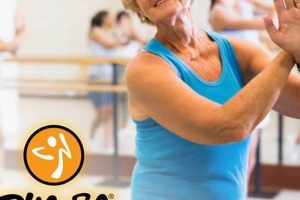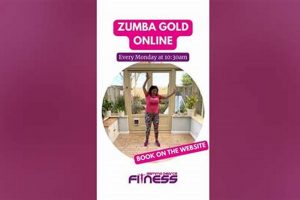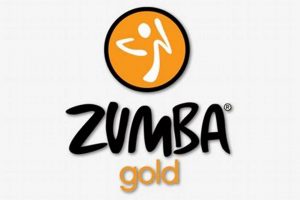This specialized fitness program modifies the original Zumba dance workout to cater to the needs of active older adults, beginners, or individuals with physical limitations. It focuses on simpler choreography, lower impact movements, and a slower pace. The goal is to create an accessible and enjoyable exercise experience. For example, instead of high-energy jumps, participants might perform modified steps with a focus on balance and coordination.
The significance of this approach lies in its ability to promote cardiovascular health, improve muscle strength, and enhance flexibility without placing undue stress on joints. Its historical context is rooted in the growing awareness of the importance of age-appropriate exercise programs and the desire to adapt popular fitness trends to a wider audience. Benefits extend beyond physical well-being, fostering social interaction and improving mental acuity.
The following sections will delve into specific aspects of the program, including common choreography, modifications for various physical limitations, and the overall impact on participants’ health and well-being.
Guidance for Adapted Dance Fitness
The following guidelines are designed to optimize participation and maximize benefits within this low-impact dance exercise environment.
Tip 1: Maintain Controlled Movements: Prioritize smooth, deliberate actions over rapid or jerky motions to minimize the risk of joint strain. For instance, execute arm raises with a steady pace and full range of motion, avoiding sudden accelerations.
Tip 2: Focus on Core Engagement: Consciously activate the abdominal muscles throughout the exercise session to improve posture, balance, and stability. This can be achieved by gently drawing the navel towards the spine.
Tip 3: Adapt Stance for Stability: Adjust foot placement to enhance balance and reduce the likelihood of falls. A wider stance provides a more stable base of support during lateral movements or weight shifts.
Tip 4: Use Modified Steps: Replace high-impact jumps or leaps with lower-impact alternatives, such as marching in place or stepping side to side. The objective is to maintain cardiovascular activity without placing excessive stress on the joints.
Tip 5: Hydrate Regularly: Consume water before, during, and after the exercise session to prevent dehydration and maintain optimal performance. Small, frequent sips are generally more effective than infrequent large gulps.
Tip 6: Listen to the Body: Pay close attention to any signals of pain or discomfort and modify or discontinue exercises as needed. Pushing through pain can lead to injury and should be avoided.
Tip 7: Utilize Support When Needed: Use a chair or wall for balance support if necessary. This can help maintain stability and confidence during exercises that challenge equilibrium.
Adherence to these principles promotes a safe and effective exercise experience, contributing to improved physical function, reduced risk of injury, and enhanced overall well-being.
These principles provide a foundation for understanding the execution and benefits of movement modifications, leading to a richer appreciation of the exercise format.
1. Modified Choreography
Modified choreography forms a core tenet of Zumba Gold, serving as the primary mechanism through which the original Zumba fitness program is adapted for a different demographic. The causal relationship is evident: standard Zumba’s high-intensity, complex routines are often unsuitable for older adults or those with physical limitations, necessitating simplified and adapted sequences. Modified choreography prioritizes slower tempos, repetitive steps, and reduced range of motion. A crucial component is the removal of high-impact elements such as jumping or complex turns, replaced by alternatives that minimize joint stress.
An example of this modification is replacing a salsa step involving quick weight shifts and multiple foot movements with a simplified version involving a single step to the side, followed by a weight transfer. Instead of a merengue with rapid hip movements, the modified version may focus on gentle swaying and shoulder rotations. This approach allows participants to engage in the physical activity and enjoy the rhythmic nature of the dance without risking injury or overexertion. Understanding this modification is practically significant for instructors who must be able to adapt routines on the fly to accommodate participants’ diverse abilities and limitations.
In summary, modified choreography is not merely a change in steps; it’s a fundamental principle ensuring accessibility and safety within the Zumba Gold framework. While it presents challenges in maintaining the energy and excitement of standard Zumba, the benefits of increased participation and reduced risk of injury far outweigh these concerns. This adaptation links directly to the program’s broader goal of promoting physical activity and social engagement in a safe and inclusive environment.
2. Lower Impact Intensity
Lower impact intensity serves as a cornerstone of the adaptation of Zumba dance fitness for specific populations. Its implementation is directly linked to mitigating the risk of injury and increasing accessibility for individuals who may experience joint pain or have limited mobility. The cause-and-effect relationship is demonstrably clear: standard Zumba involves high-impact movements such as jumping, running in place, and rapid changes in direction. These activities place significant stress on the joints, particularly the knees, ankles, and hips. Lowering the intensity reduces this stress, enabling wider participation.
The importance of reduced impact is evident in the modifications made to typical Zumba routines. For example, instead of performing a jumping jack, participants might step out to the side and raise their arms. A high-energy run in place could be replaced with a simple march, ensuring that at least one foot remains in contact with the ground at all times. These seemingly small changes collectively contribute to a significant reduction in the overall impact experienced by the body. The practical significance of this understanding lies in the ability to safely incorporate cardiovascular exercise into the lives of individuals who might otherwise be excluded from such activities. Instructors are tasked with consistently modifying routines to maintain engagement while adhering to the low-impact principle.
Maintaining lower impact intensity presents a specific challenge: retaining the energy and enjoyment of the standard program while minimizing physical stress. Addressing this requires careful choreography, a focus on large muscle group engagement without high-impact actions, and constant awareness of participant feedback. Nevertheless, the benefits of increasing accessibility and decreasing risk of injury outweigh the challenges, underscoring the critical role it plays in the overall effectiveness and inclusivity of the activity program.
3. Balance Enhancement
Balance enhancement is a critical objective within the design and implementation of Zumba Gold programs. Its importance stems from the age-related decline in balance and stability, which increases the risk of falls and related injuries. The following facets explore how Zumba Gold incorporates and promotes improved balance.
- Core Strengthening
Core strength is fundamental to maintaining upright posture and stability. Zumba Gold routines often incorporate movements that engage the core muscles, such as gentle twists and controlled lateral movements. These actions help to strengthen the abdominal and back muscles, providing a more stable base of support. For example, during a cha-cha step, the controlled rotation of the torso activates core muscles, enhancing balance. This strengthening is directly beneficial in everyday activities, reducing the risk of falls when reaching or bending.
- Weight Shifting and Coordination
Many steps involve shifting weight from one foot to the other, requiring coordination and balance. The modified choreography emphasizes controlled weight transfers rather than rapid shifts, allowing participants to gradually improve their stability. A simple salsa step, for instance, requires shifting weight while maintaining an upright posture. This practice translates directly to improved balance during walking, climbing stairs, and other functional movements.
- Postural Awareness
Zumba Gold routines often include cues that prompt participants to be mindful of their posture. Maintaining an upright posture with shoulders back and core engaged enhances stability and reduces the risk of falls. Instructors may provide verbal reminders to “stand tall” or “engage your core.” This heightened postural awareness carries over into daily life, promoting better balance and reducing strain on the body.
- Functional Movements
The routines often incorporate functional movements that mimic everyday activities, such as reaching, bending, and twisting. By practicing these movements in a controlled environment, participants can improve their ability to maintain balance during real-world tasks. Reaching for an object while maintaining balance, for example, is a common functional movement incorporated. This practice enhances stability and reduces the risk of falls during everyday tasks such as reaching for items on a shelf or bending to pick something up.
Through these incorporated facets, Zumba Gold actively contributes to balance enhancement. By strengthening core muscles, improving weight shifting coordination, promoting postural awareness, and incorporating functional movements, the program supports improved stability and reduces the risk of falls. These multifaceted benefits underscore the value of Zumba Gold as a means of promoting physical and functional well-being.
4. Social Engagement
Social engagement constitutes a significant component within the Zumba Gold framework, extending beyond mere physical activity to encompass social interaction, emotional well-being, and a sense of community. This aspect directly impacts participant adherence and overall program effectiveness.
- Reduced Isolation and Loneliness
Participation in Zumba Gold classes provides structured opportunities for social interaction, thereby reducing feelings of isolation and loneliness often experienced by older adults. Regular attendance fosters relationships and a sense of belonging. For example, participants may interact before and after class, sharing experiences and forming friendships. This combats social isolation, which has documented negative impacts on both physical and mental health. The structured environment facilitates interaction, which is particularly beneficial for individuals who may have limited social networks.
- Increased Motivation and Adherence
The social support and camaraderie cultivated within a Zumba Gold class enhance motivation to attend regularly. Participants are more likely to adhere to the program when they feel connected to others and experience a sense of accountability. Knowing that others are expecting one’s presence can serve as a powerful motivator. The shared experience of learning the choreography and achieving fitness goals fosters a sense of collective accomplishment, further solidifying commitment.
- Improved Mental Well-being
Social interaction is directly linked to improved mental well-being. Engaging with others releases endorphins, reduces stress, and promotes a sense of happiness and contentment. Zumba Gold provides a positive and supportive environment that encourages laughter, shared experiences, and a sense of connection. This can be particularly beneficial for individuals experiencing anxiety or depression. The social support received from classmates and instructors contributes to improved self-esteem and a more positive outlook on life.
- Cognitive Stimulation
Social engagement provides cognitive stimulation, which is crucial for maintaining cognitive function. Interacting with others requires communication, problem-solving, and memory recall. Learning choreography and coordinating movements within a group setting further challenges cognitive abilities. The combination of physical activity and social interaction offers a synergistic effect on cognitive health, helping to maintain mental sharpness and prevent cognitive decline.
The multifaceted benefits of social engagement within Zumba Gold underscore its importance as an activity that promotes not only physical health but also social, emotional, and cognitive well-being. The program provides structured opportunities for interaction, fosters a sense of community, and contributes to improved quality of life for participants.
5. Joint-Friendly
The “joint-friendly” nature is a fundamental characteristic of Zumba Gold, designed to mitigate the potential for musculoskeletal stress often associated with higher-impact exercise programs. This characteristic directly stems from the program’s primary objective: to provide a safe and accessible form of physical activity for older adults, beginners, and individuals with physical limitations. The causal relationship is clear; high-impact exercises inherently place greater force and stress on joints, potentially exacerbating pre-existing conditions or leading to new injuries. Therefore, a deliberate reduction in impact and modifications to movement patterns are crucial to ensure the exercises are suitable for sensitive joints. For example, traditional Zumba steps that involve jumping or high-impact landings are replaced with steps that keep at least one foot on the ground at all times, thereby minimizing the force transmitted to the knees, hips, and ankles.
The importance of a “joint-friendly” approach is exemplified in the modifications of common dance steps. Instead of a traditional grapevine step that may involve quick changes in direction and potential ankle strain, a modified version might involve a slower, wider step, allowing for greater stability and reduced stress on the ankle joint. Similarly, arm movements are often performed with a reduced range of motion, minimizing the risk of shoulder impingement or other upper extremity issues. These modifications require instructors to possess a thorough understanding of biomechanics and the potential impact of different movements on the joints. The practical significance of this understanding extends to the ability to adapt routines in real-time, based on individual participant needs and limitations.
In summary, the “joint-friendly” aspect is not merely an ancillary benefit but a core design principle underpinning the effectiveness and accessibility of Zumba Gold. While maintaining a low-impact approach may present challenges in replicating the intensity and excitement of traditional Zumba, the resulting reduction in injury risk and increased participation among individuals with joint sensitivities outweigh these concerns. This design promotes long-term adherence and maximizes the program’s positive impact on overall health and well-being.
Frequently Asked Questions about Zumba Gold Moves
The following section addresses common inquiries regarding the fitness program’s actions, providing clarity on various aspects of its methodology and benefits.
Question 1: What are the specific movement modifications employed within the program?
The program modifies traditional dance steps to reduce impact and increase accessibility. Jumping and high-impact steps are replaced with lower-impact alternatives, such as marching in place or stepping side-to-side. Range of motion is often reduced in arm movements, and quicker turns are substituted with slower, more controlled rotations.
Question 2: Is prior dance experience a prerequisite for participation?
No, prior dance experience is not required. The routines are designed to be easily followed, even by individuals with no prior dance training. Instructors provide clear cues and modifications to accommodate varying skill levels.
Question 3: What are the primary benefits of engaging in modified dance fitness?
The program provides a range of benefits, including improved cardiovascular health, increased muscle strength, enhanced flexibility, better balance, and increased social interaction. The low-impact nature makes it suitable for individuals who may not be able to participate in higher-intensity exercise programs.
Question 4: How does the program address the needs of individuals with limited mobility?
The routines can be further modified to accommodate individuals with limited mobility. Participants may perform exercises while seated or use a chair for support. Instructors are trained to provide personalized modifications to ensure that all participants can engage safely and effectively.
Question 5: What is the typical duration and frequency of classes?
Classes typically last between 45 and 60 minutes. The recommended frequency is two to three times per week, but individuals may adjust their participation based on their personal preferences and fitness goals.
Question 6: How can one locate qualified instructors and certified classes?
Certified instructors can be located through the official Zumba website. This resource provides a directory of instructors and classes in various locations. It is recommended to verify the instructor’s certification and experience prior to participation.
In summary, the fitness regimen offers a safe, accessible, and enjoyable way for individuals of all ages and abilities to improve their physical and mental well-being. Its low-impact nature, modified routines, and social engagement aspects make it a valuable addition to a healthy lifestyle.
The subsequent section will explore specific case studies and success stories, highlighting the transformative impact of engaging in dance-based exercises.
Conclusion
This exploration has detailed the multifaceted nature of “zumba gold moves,” highlighting its modifications for accessibility, reduced impact intensity, promotion of balance, fostering of social engagement, and its joint-friendly design. These core elements collectively contribute to a fitness program tailored to the needs of older adults, beginners, and individuals with physical limitations. The program’s emphasis on modified choreography and slower tempos distinguishes it from traditional dance fitness programs, making it a safe and effective option for a wider range of participants.
The understanding and implementation of these strategies remains critical for promoting sustained participation and maximizing the health benefits derived from this form of physical activity. As the population ages, the importance of accessible and engaging exercise programs will only continue to grow, underscoring the lasting significance of “zumba gold moves” as a valuable tool in promoting overall well-being.







